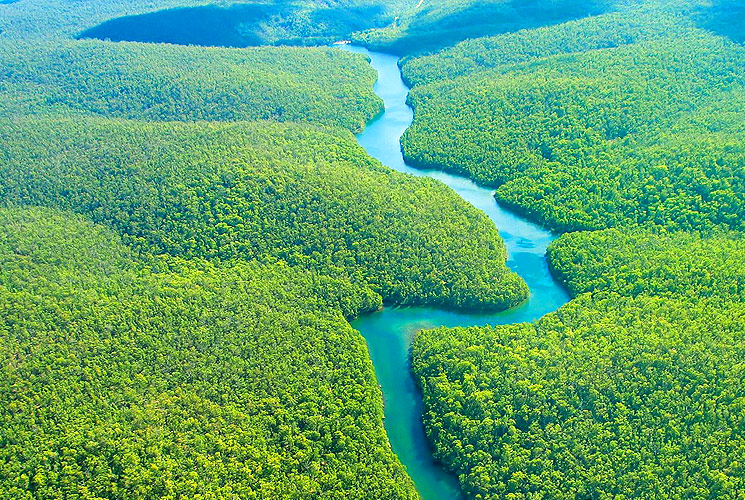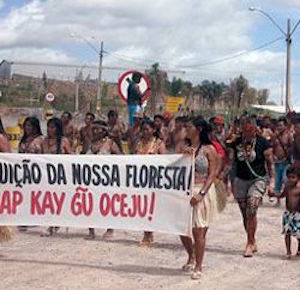By Rona Fried October 27, 2013

When I read news like the June 26 post on Bloomburg.com that “Renewable energy may supply more electricity than nuclear or natural gas by 2016,” I get excited. But then I realize that will mostly come from big hydro, which I don’t believe should be counted in that mix.
Before Japan’s nuclear meltdown, it looked like the world could be ready for a nuclear renaissance, but it seems we are entering a big hydro renaissance instead.
China’s Three Gorges Dam, the world’s largest at 22.5 gigawatts (GW), looks like small potatoes compared to those planned for Africa’s Congo and Brazil’s Amazon.
And China just approved construction of another enormous 20-GW hydroelectric project with a much taller, even more destructive dam than Three Gorges: the Sichuan project. There’s also 7,165 megawatts of hydro planned in alaysia, which would flood 900 square miles (2,300 square kilometers) of rainforest to build 20 dams.
Brazil’s Amazon
Brazil is spending $93 billion on 20 hydropower plants and 34 dams that threaten 2,500 square miles (6,500 square km) of Amazon rainforest. One of those dams, the 11-GW Belo Monte dam, would be the third-largest in the world and is 20 percent complete.

Indigenous people, desperately trying to preserve their home in the rainforest, have blocked further construction for the past year. This one dam would flood 200 square miles (500 square km), causing massive deforestation, greenhouse gas emissions and irreparable damage to the ecosystem, displacing over 20,000 people from 40 ethnic groups. The Xingu River is their lifeline.
According to Common Dreams (commondreams.org), protesters published a letter to the government saying, in part:
“We’re not leaving until you get out of our villages. You have made the fish disappear and you are robbing the bones of our ancestors who are buried on our lands…You are the ones killing us, quickly or slowly. We’re dying, and with each dam that is built, more of us will die. When we try to talk with you, you bring tanks, helicopters, soldiers, machine guns and stun weapons.”
If the government gets away with building Belo Monte, many are terrified that it will lead to destruction of all the Amazon’s magnificent rivers, which provide one-fifth of the world’s fresh water. “The Amazon would become an endless series of lifeless reservoirs, its life drained away by giant walls of concrete and steel,” says International Rivers (internationalrivers.org).
As for Belo Monte, explosions to divert the river and excavate for the dam foundation have already rendered the Xingu no longer fit to drink. Fish populations are devastated and there is little left to eat.
In Chile, presidential candidates are being asked to formally pledge to keep Patagonia free of dams and invest in renewable energy instead. A major hydro project, HidroAysén, would build five dams in yet another pristine region of Patagonia. It has been stalled for a year because of wide- spread protests.
Africa’s Congo
Now we hear that Africa’s Democratic Republic of Congo is working on an even bigger hydro project that would be the largest in the world. Construction of the first phase, the Inga dam on the Congo River, is set to begin in 2015.
This first phase is big enough, at 4.8 GW, but eventually, the Grand Inga project would scale to 40 GW, at a cost of $80 billion — with the capacity to provide electricity to half the African continent at almost twice the size of China’s Three Gorges Dam. How much could $80 billion buy in solar and wind energy?
The Congo River is the world’s largest by volume after the Amazon River. The $12 billion initial phase has been held back by lack of financing, but recent support from the World Bank and African Development Bank makes construction more like- ly, and South Africa has agreed to buy almost half the output.
Over the past 40 years, huge hydro projects have been promoted as the solution for bringing electricity to the world’s poorest country, the Democratic Republic of Congo. Because of rampant corruption and mismanagement, dams have been boondoggles. Existing dams run at about a quarter of capacity and 85 percent goes to the mining industry, says Peter Bosshard, policy director of International Rivers.
Grid-based electrification is not a realistic option for most of Africa’s poor. As usual, their thousands of small vil- lages would be much better served by distributed renewable energy and micro hydropower.
Ethiopia has already begun diverting the Blue Nile to begin building the Grand Ethiopian Renaissance Dam, a 6-GW project. Egypt, which is downstream and has virtually no other water source, is furious about the secretive project and immediately called for it to stop. The dispute could trigger a war.
Meanwhile, research shows that big hydropower plants can’t operate without intact rainforests, because without them there is less rain to keeps reservoirs full. If deforestation continues, the Belo Monte dam may only deliver one-third of its design capacity. A study published in Proceedings of the National Academy of Sciences finds that rainfall has already fallen 6 to 7 percent because of deforestation related to the Belo Monte construction. Rainfall is expected to drop 11 to 15 percent if estimates of 40 percent deforestation by 2050 are correct, resulting in 35 to 40 percent less power.
How sad that solar, wind and other renewables are classed with these destructive hydro projects.
About the author:
Rona Fried, Ph.D., is president of SustainableBusiness.com, a thought leader on green business known for its daily news and Green Dream Jobs service since 1996.




